< Previous | Contents | Next >
Battles Long Ago
BUNNY. A lovely village near Fairham Brook, flowing through willows and rich meadows, half a mile from the famous hill which was the despair of the old coach and the early car, it has famous names among its landlords, the memory of Henry the Seventh's soldiers spending the night in Bunny Wood before the last battle of the Wars of the Roses, and the echo of Royalist and Cromwellian troops passing by in the Civil War.
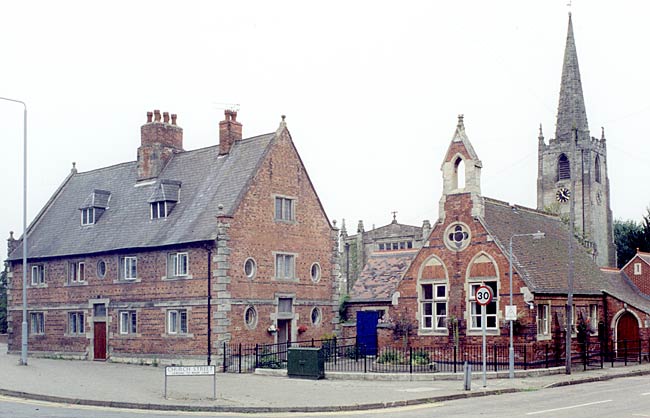
Bunny village in 2003.
Bunny owes much of its beauty and interest to the Parkyns, and we are glad to have known it before the builder disturbed its dress of mellowed brick, which was a testimony to one of the strangest of Nottinghamshire men, Thomas Parkyns, the Wrestling Baronet. It was a later member of the family, Lord Rancliffe, who made himself a lasting memorial by planting Rancliffe Wood and clothing Windmill Hill with trees.
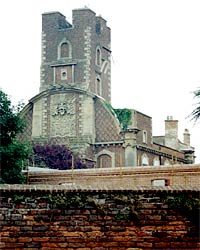
The belvedere at Bunny Hall in 2003.
Sir Thomas was the second baronet of a family honoured by Charles the Second for their service in the Civil War, especially that of Colonel Isham Parkyns, who was Governor of Ashby de la Zouche. After his father's death he began to improve the village and the lot of his tenants, and for the rest of his 78 years was a good friend to Bunny. He gave two bells to the church, restored the chancel, built a vicarage, rebuilt nearly all the farmhouses and dwellings, and made plantations. He lived at the hall, a strange mixture of brick and stone, and gave it the curious tower we see, with its elaborate coat-of-arms and a fine oak staircase climbing to the top. He enclosed its lovely park with a wall three miles long which took three scars to build, said to be the first wall in England to be built on a foundation of arched brickwork. The tops of some of the arches are plainly seen where the wall runs by the lane.
The gem of all his building is the charming block of four almshouses and a school at the church gate, with tiny leaded windows (round and square), and quaint dormers in the mottled roof. On the school, now used as a village room, is one of the Latin quotations of which he was fond, "Learning has no enemy except ignorance." He was a great student and compiled a Latin Grammar for the benefit of his grandson, but it was through his passion for wrestling that he won his reputation.
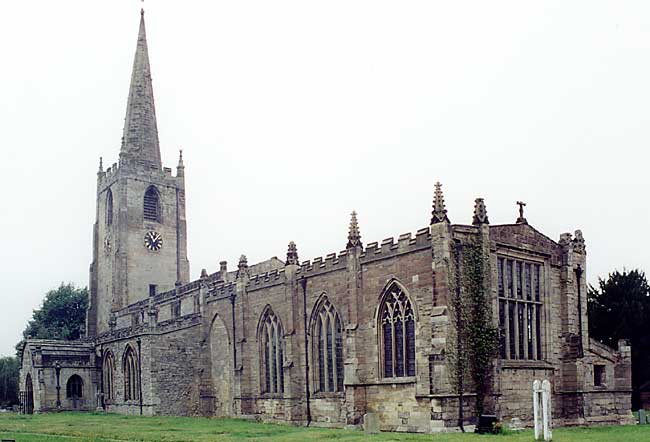
Bunny church in 2003.
Lovely outside and in, the church is adorned with pinnacles, battlements, and bands of quatrefoils. The 14th century tower, with a graceful spire, has a lofty archway opening to the nave with 14th century arcades. One of its glories is the 15th century porch, of exceptional size and beauty, with a big window each side and a stone vaulted roof. The other is the great white-walled chancel, which was delayed in its building by the coming of the Black Death: it has lovely sedilia and a double piscina, and many windows filling it with light. The frame of the old chancel screen remains, with some original tracery and carved spandrels, but it has been given a poor modern cornice. There is an old chest, a new font, and a good old font.
In the chancel are many of the Parkyns memorials. Richard of 1603, Recorder of Notts and first of the family to live at Bunny, kneels facing his wife, the tiny figures of their eight children with them. A blue and white monument has a lovely draped figure bowed over the bier of the last Sir Thomas, who was so fond of hunting that in his old age he used to put on his scarlet coat and his cap to watch the hounds from his window. He died soon after Trafalgar.
Looking out from the wall as she kneels, with a wrap over her head, is Dame Anne Parkyns, the Lady Bountiful of Bunny. She was the mother of the Wrestling Baronet, and his helper in all his good works. She died in 1725, and we read that she came as a blessing into the family, and God drew out her precious life to 92 years. Her face is very beautiful.
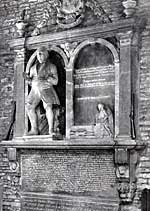
Monument to Thomas Parkyns in Bunny church.
But the monument that draws all eyes is that of her son, who stands ready for a wrestling bout, a lifesize figure, while at the side we see hia tiny figure stretched out on the floor, defeated at last by Time. Part of his epitaph runs:
That Time at length did throw him it is plain,
Who lived in hope that he should rise again.
It is said that Sir Thomas had the monument made before his death and set up in the chancel; now it is in the north aisle. He lies in the vault he built, in one of the stone coffins he used to collect.
The Wrestling Baronet
THOMAS PARKYNS, one of Nottinghamshire's oddities, was born in 1663, and educated at Westminster School and Trinity College, Cambridge. He studied law at Gray's Inn, was a lover of Latin, and had a knowledge of mechanics, mathematics, and architecture.
Whatever this man of vigorous mind and generous spirit did he did thoroughly. Interesting himself in education, he compiled a Latin Grammar which was one of the earliest books published in Nottingham. He was a keen magistrate, and a student of the economics of his day: and he learned something of the art of medicine so that he could prescribe for the poor. He bought many neighbouring manors, and used much of the fortune he inherited in good works. One of his eccentricities was his fondness for displaying Latin quotations about his estate; another was his habit of collecting stone coffins, which he gave to anyone who wanted one. A fine athlete, he never had a day's illness till he was 78, and even in middle life was a good runner and a tireless bellringer.
But his fame lay in his love of wrestling. He is remembered as the Wrestling Baronet; he called himself Sir Thomas Luctator. He established an annual wrestling match in the village for which the prize was a gold-laced hat, and the practice was kept up for nearly a hundred years after his death. He kept two wrestlers at Bunny to give him exercise and to train likely pupils, taking into his service those who could give him a fall. His own notions about the rules of the game he put in the curious book he wrote to make wrestling popular, calling it the Inn Play or Cornish-Hugg Wrestler.
One of the most remarkable squires of his day, he was like Sir Roger de Coverley, with many eccentricities but with a heart of gold.
The Vale of Trent
BURTON JOYCE. A new road has straightened its old winding way between a low ridge of hills and a bank of the Trent; and many new houses with trim gardens keep company with old cottages.
One of England's great cricketers knew the village as it used to be, for he was born here. He was Alfred Shaw, Emperor of Bowlers, who sleeps at Gedling.
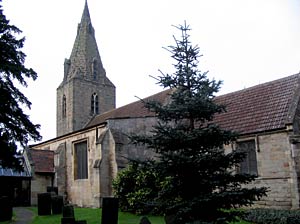
Burton Joyce church in 2005.
In a churchyard where we look over the wide Trent vale to the Malkin Hills and the fine tower of Shelford is the much-restored old church, largely built during the 14th century. The low spire, with two tiers of windows, was struck by lightning half a century ago, and eight feet of the top was taken down and built into a pyramid near the porch.
As old as any part of the building is the beautiful east window of the north aisle, coming from the time of Edward the First. The bowl of the font and the middle pillar on which it rests are 13th century; so is a floorstone carved with a cross in the north aisle. Leaning against the wall of this aisle is the massive stone altar with two consecration crosses found when the church was restored. Here, too, is a great peephole like a window, and by it an old piscina.
The dim but pleasing little chancel has linenfold panelling on the walls, and surmounting the richly traceried panels of the reredos is a deep border like lace in the delicacy of carving. The east window has a lovely Crucifixion and figures of St Helena and Paulinus, who is said to have baptised his converts in the Trent hereabouts. Beautiful glass shows St Edith of Wilton and St Elizabeth of Hungary, and another window has Mary and Martha of Bethany. The pulpit and lectern were made from beams of the old roof.
On a stone tomb lies Robert de Jortz de Bertune, a 13th century knight of the powerful family who gave the village its name (Bertune Jortz). He wears plate armour, and his belt is of flowers. His head is remarkably small for his body.
The portrait of Sir Brian Stapleton, who died in 1550, is engraved on an alabaster stone, showing him in armour with dogs at his head and feet. His son Brian was one of the husbands of Alis Roos, whose figure has almost vanished from a very worn stone.
